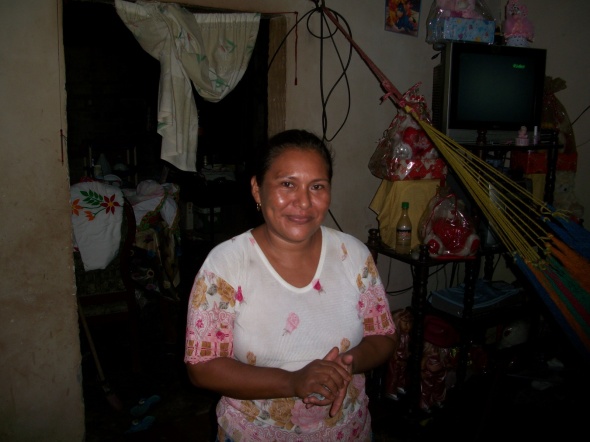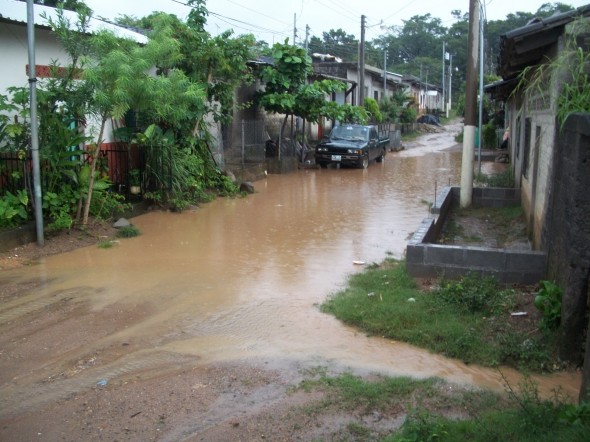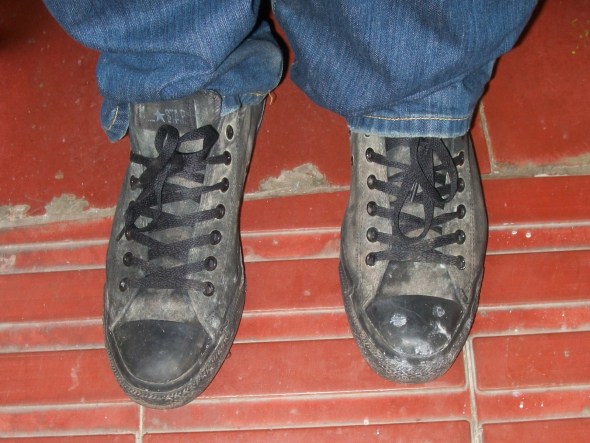La Capital

Día 77, 10/18/2010
San Salvador
Yesterday afternoon, I arrived in the Capital. San Salvador is unlike any city I´ve ever been in. It´s more modern, developed, and diverse than I expected. It´s also extremely crowded, polluted, and disorganized. A lot of the city reminds me of places I visited in the Middle East – some of the chaos of Cairo, sprinkled with the modernity of Tel Aviv, flattened into the layout and flat profile of Los Angeles, with dense single-story concrete and brick homes that look similar at first glance but are actually extremely different, and all painted a variety of tropical colors as if you were in the Rainforest Café and sprinkled with European-style parks in the middle of street islands and rebuilt war-torn blocks.
The City is a top-3 hub for Latin American business and has strong cultural and practical ties to the United States. For a variety of reasons, it is not a hub for gringos. Rule #1, unfortunately, is to not take my camera anywhere, which puts a lot of pressure on my figurative writing abilities. The best part of my day was realizing that my much improved Spanish and developed skill of acquiring and wearing old American printed t-shirts lets me blend in better than I would have guessed. Taxistas bothered other people, lost travelers asked me directions on the street, and best of all, the checker at the supermarket asked me “What part of Colombia are you from?” and a bartender told me that he doesn´t serve “arrogant Spaniards like you until they apologize for all of their bullshit” (both interesting results of a leftover Madrileño-spanish accent). Both of these occurrences made me extremely happy.
I spent the afternoon walking around a middle-class neighborhood near a major University and playing basketball with a bunch of middle schoolers. The neighborhood where I´m staying is fun – there are a ton of bars, restaurants, and parks. There´s also the nicest supermarket I´ve even seen in Central America, with someone cooking filet mignon grilled cheese sandwiches on a griddle and giving samples. The meat section included calf heart, lots of feet and bones that were very expensive, and massive tongues. I didn´t try any. On my way home, I ran into the San Salvador Shiite Muslim Organization Headquarters, and as I was looking in the window a security guard asked me if I wanted a tour, and I ended up drinking tea with a bunch of old guys with no teeth and talking about the different parts of the capital and if the mosque should be built in downtown New York.
This morning I´m sitting in the gigantic offices of the site of my new project, waiting to get clearance for the internet, which has to go through at least four people. I´m wearing a tie for the first time, shaved last night, and just met like 20 people in charge of different departments of whom I don´t remember any names. The last bank I worked with had a portfolio of almost $4 million and 20 total people in my office, they self-titled themselves “cowboys like Clint Eastwood.” This one has a $60 million portfolio and people flying to Europe every few weeks to meet with funders; there´s a little more nuance going on all around. Navigating the city in the next few weeks will be an adventure, but so far it´s a lot of fun to be somewhere with a lot of energy and a little bit of an attitude from my more relaxed, turn-the-streetlights-off-at-7PM prior digs.
What Storm
Today was a big day – fun motorcycle ride, first time several rural roads have been open since the hurricane started, first sampling of popcorn with lime and chile, final borrower visit of the week.
The visit started great – blue skies, clouds, fresco (great temperature). But right after we walked inside of Ana Ruth´s house in Colonia San José on the outskirts of Gotera, a big bang of thundered shuddered through her house.
Ana was busy in the back of her house, making a big batch of atoll (oatmeal-based drink with cinnamon, cardamom, and lots and lots of sugar) and corn tamales under her tin-roof-covered patio, while rivers of water started to get bigger and bigger in the backyard. She was excited to see us, and especially Alex, the loan officer I went with, who had recently introduced her to someone who´s going to help her with delivering tortillas and firewood to people in her neighborhood. Ana´s 35, and lives in her house with her four children, aged 6 to 18. Ever since their dad moved away, Ana´s been waking up at 4:30AM to start preparing tortillas and tamales to sell for breakfast. At 7, she takes a break and gets everyone ready for school, and once they´ve all arrived there she returns home to make rounds to many of her neighbors, who count on her for breakfast and for supplying their wood-burning fires.
We spent a lot of time with Ana and her kids, who were very excited to learn new “gringo dances.” Ana´s been making plans to grow her business and expand delivery, and has been working on the best way to prepare for the expenses coming with her children´s education. We talked with her about her goals, and the best ways to plan for the expenses of her loan payments and savings schedule. Ana was a great example of both someone who´s acting on their ambition and following through on the tough decisions that come with saving money and using credit, and someone who has absolutely no access to financing from traditional sources. Ana had never thought that anyone would loan her money to try to grow her business, and she has a really strong feeling of obligation to follow through on her agreements to pay back the faith that her creditors have placed in her. We spent a long time in her house waiting for the rain, and after a lot of recent ups and downs I felt really good about the world leaving her place.
Actually driving away on the motorbike, however, was a little trickier.
Dawgs
Día 69, 10/10/2010
On a break last weekend, I met two other Kiva buddies and went on a wave/seafood hunt. The beach was great, and we actually got a lot of work done scouting the area of my next assignment.

Financing the Developing World
A big recent study called Portfolios of the Poor: How the World´s Poor Live on $2 a Day has been making a lot of waves with its insights into how the developing world manages its finances. This is a really interesting and short brief about some of its conclusions, including a lot of surprising ideas about the improtance of cash flow and prevalence of financial access.
Here´s also a blog post by its authors about the basics of microfinance, and the original posting of the study on Kiva.org.
Nica Déjà Vu
I´m putting this picture on here in case anyone is hiring a professional landscape photographer, even though it´s old from a Septiembre trip to Nicaragua.
Visitas
Día 68, 10/9/2010
This has been an intense week, doing lots of traveling in lots of vehicles to meet and talk to a sample of clients within Kiva´s program. Although Eastern El Salvador is pretty small, it´s transportation options are a little less developed, and it can take a while and a lot of trouble to get around. Every day on my way home I think about what I´ve done over the last four years, and sometimes it´s hard to reconcile the memory with the current reality, spending the day with people who work incredibly hard and have an incredible responsibility to sustain others around them, regardless if they´re 18, 35, or 60. No one ever complains, and the creativity required to get things done is many times really really impressive. These were two of my favorite new friends –
Veronica lives in a super fun and isolated community, and has been raising chickens in her parent´s back yard for three years. She´s 19, and lives with her boyfriend, two-year old son, 299 nice chickens, and one mean chicken. From starting with three hens, to selling eggs to her neighbors, to now having a big enough pen that she can sell defeathered chickens for cooking every week and still maintain her “flock.” Veronica´s business had been so successful that she´s been able to involve family members in need of work, and it´s growing more and more all the time.
Maria lives outside of Gotera, and the only access to her house is on a road with a bridge that often floods in the wintertime. She makes comales, big clay griddles that everybody uses to cook everything, and is an expert comale-crafter. Wintertime (rainy season, now) is tough for her business. Besides problems with the bridge and transportation, the comales dry in the sun, and there hasn´t been very much sun for a while. Maria dries her griddles in a large wood-fired oven sometimes, but this makes them a lot more likely to break, and uses up a ton of firewood. But Maria is working on some solutions, including building up extra inventory in a storehouse during the dry season, and is making due as best she can with the stormy weather.
La Gotera
These pics, from a fog-run away from the crazy wild dogs-don´t get caught in a flash flood hike, are what it really looks and feels like where I live.
San Miguel
I spent Sunday in neighboring town of San Miguel, second largest in El Salvador, talking to people in the market. San Miguel is a wild place – super urban, with some colonial influence, it suffers from a lot of gang activity and a deteriorating infrastructure. Everyone I met was extremely nice, and I learned a lot about the relocation of perishable goods from rural to urban areas.
Kicks
These Cons used to be dark black, but like several articles of clothing I own, are now serving as lunch for a variety of mold and even small mushrooms. It’s quite a unique style, and I´ve seen a few different colors – investigating the potential for a new business opportunity at home.




















Recent Comments